
It is November. Some how the summer got away from me. July folded and stitched itself directly to this month of declining light, leaving August through October tumbled in that shaded pocket.
Work keeps me very active late summer through Halloween. Family events, unexpected surprises and some pretty big life challenges, furthermore, made quick work of July’s crafting project.

Only 4 Weeks Old
One of the unexpected turns that came about at the end of September, is the addition of two new fur babies in the form of orphaned feral kittens. Yeah…I thought I was going to foster them, but who am I kidding? Long story short, Luna Rueyn and Mi Suri Bella (Misu) are not going to be leaving any time soon. At 10 weeks they are the sweetest bundles of smokey tortoiseshell mischief that this surrogate kitty mom could ever wish for. Even if I didn’t wish for them in the first place. Oh well…I’m sunk.
November isn’t waiting around for anyone either and I am deep in the process of playing catch up and get ready as the holiday season is knocking at or rather knocking down the door, it seems.

Summer found me wandering in many novel (to me) places as I helped my brother and sister in law move from Fort Collins, Colorado all the way to Killin. Alabama. I’m still not sure I have forgiven them for that far away migration, but I certainly made the most of the adventure.
Who knew that the eastern side of Kansas, would be so lush and green? Certainly I didn’t! In my mind Kansas had always been one long stretch of flat dry prairie. I basically viewed it as a tornado runway where ones entire house might be lifted up and deposited in another dimension no matter where it was located withing the boundaries of this state. (Thank you L. Frank Baum and Hollywood). But this is not so! The geology seems to change about midway through, with flat land turning to gently rolling wooded hills which grow greener in intensity on through Missouri all the way to Bamy.

For the first time I experienced the vast and ambling waterscapes of the Great Mississippi and Tennessee rivers. The later of which whose shoreline I got to wander along. These two mammoth rivers flow so very different from the rough and ready tumble of the Provo and American Fork rivers along the Wasatch. My rocky mountain homegrowns seem more like creeks in comparison.
 In the backyard of my brother’s new home, I fell into a wonderment of crimson – a curious cardinal, and became utterly enchanted by the ethereal flight of the lightening bug. I have been told there are such insects in Utah at certain times of the year. I might have to make this a quest for the future.
In the backyard of my brother’s new home, I fell into a wonderment of crimson – a curious cardinal, and became utterly enchanted by the ethereal flight of the lightening bug. I have been told there are such insects in Utah at certain times of the year. I might have to make this a quest for the future.
 My daily walks around the country roads of Northern Alabama, were orchestrated by an ever present cacophony of cicada serenading from patches of wooded acreage. This is such a singular music, falling somewhere between buzzing of electrical wires and high tenor lawn mower. The cicada population of this year is an annual species and not the anticipated 13 (Magicicada) variety that is expected to emerge in 2024.
My daily walks around the country roads of Northern Alabama, were orchestrated by an ever present cacophony of cicada serenading from patches of wooded acreage. This is such a singular music, falling somewhere between buzzing of electrical wires and high tenor lawn mower. The cicada population of this year is an annual species and not the anticipated 13 (Magicicada) variety that is expected to emerge in 2024.
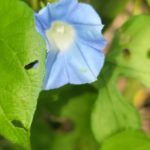
In this part of the country, long leaf pine, maple and beeches wear shawls of trumpet vine, morning glory and wisteria. This dense greenery echos the moss covered forest of the pacific northwest where I spent my teenage years. It feels familiar and appears so similar, yet remains distinct in flora and fauna from that found in the Willamette Valley and along the coast of Oregon.

While in the area I took the opportunity to visit the Florence Indian Mound and Museum. This indigenous built mound was first constructed over 1500 years ago. I climbed the steep stairway that allows visitors of the museum to explore the precipice. Always, I am humbled by these places, feeling a deep human connection, despite the troubled history of colonization. I walked the perimeter of the apex to gaze out over a landscape that stretched far to the horizon, unbroken or hemmed in by sharp peaks as it is where I live in the mountain west. The experience was beautiful, ineffable…
 I, also, very much wanted to visit the Sacred Way Sanctuary. This invaluable interpretive center, horse refuge and trading post houses more than 100 Indigenous American horses whose lineages go back for centuries and hearken from several different tribal groups. The sanctuary is further home to the remnants of ancient equine species, 0ne that roamed North America during the ice ages long before the Spanish conquistadors arrived and introduced the European breeds to the vast grasslands of this continent.
I, also, very much wanted to visit the Sacred Way Sanctuary. This invaluable interpretive center, horse refuge and trading post houses more than 100 Indigenous American horses whose lineages go back for centuries and hearken from several different tribal groups. The sanctuary is further home to the remnants of ancient equine species, 0ne that roamed North America during the ice ages long before the Spanish conquistadors arrived and introduced the European breeds to the vast grasslands of this continent.
I am sad to say they were not open for business while I was at brother’s house, so I was unable to actually participate in the tours and informative activities at the facility.

I had to settle, instead, for a drive out to the Sanctuary where I was, thankfully, able to greet a few horses that were grazing happily in a fenced pasture. One of them was particularly interested in investigating this strange woman standing along the fence-line looking on so longingly. As I have always had a huge affinity with the horse, this place is top of my list to visit when I return.

On my way back to Utah, I spent an extra week in Fort Collins, Colorado. During this time I was finally able to take my mom to Elk Mountain, Wyoming to visit the historic township and tour the wonderful Elk Mountain Museum.
My mom spent her most cherished childhood days rambling over the wooded terrain of this Wyoming giant; Her family taking residence in a tiny cabin, while her dad worked a local lumber mill. Throughout my own childhood, I have been happily regaled by tails of her adventures rambling around her beloved woodland home as a free spirited wilderness woman.

Elk Mountain juts dramatically from the surrounding grasslands through which the Medicine Bow River gently idles. Stunning and picturesque, this solitary inselburg and once sacred summit of the plains peoples, has been purchased by a single entity and proclaimed private property. No one is able to wander past the foothills these days without permission. Despite this, my mom and I drove up the hillside as far as we could go. We stopped to pick wildflowers and to collect rocks form this motherland; Touchstones connecting to that spunky, curious, wonderful child that forever shines from within my mother’s cornflower blue eyes.
Back home in Utah, we have enjoyed a spectacular fall. The changing of the leaves from summer greens to russet, amber and ocher set the mountains a flame by late September. This fiery display burned clear through October before cooling slowly to brown and crisping embers. The first snow took us by surprise just after Halloween, dropping temperatures over 20 degrees over night. This I did not love so much.
Through it all, I have continued to find respite, solace and beauty through wandering the wilderness spaces.
 Along the expansive shoreline at Utah Lake this morning, storm clouds mist the wind swept water, as well as myself as I meander through the shallows. Suddenly I catch sight of a large dark shape skimming and then rising above the water line…to big for hawk or gull, it’s shape distinct even from the osprey I see in summer. This is a singular silhouette, formidable, with expansive wings tipped with fierce feathers splayed defiantly against a tempest shrouded sun.
Along the expansive shoreline at Utah Lake this morning, storm clouds mist the wind swept water, as well as myself as I meander through the shallows. Suddenly I catch sight of a large dark shape skimming and then rising above the water line…to big for hawk or gull, it’s shape distinct even from the osprey I see in summer. This is a singular silhouette, formidable, with expansive wings tipped with fierce feathers splayed defiantly against a tempest shrouded sun.

The American bald eagle has left it’s northern abode to feast on carp and other fish abundant in Utah’s pluvial lakes. From now through February these beautiful raptors will find refuge and nourishment in these sheltered valleys.
It is a marker on the wheel of the year for me. This returning of the eagles. A visceral reminder of the invisible process; Time ever spiraling forward on the broad shoulders of a great and ghostly bird.










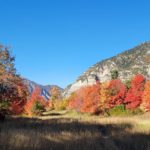







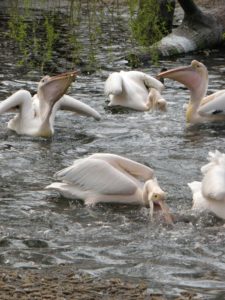 That’s right, these clever birds, will flock together in the water, using coordinated efforts to force schools of fish into the shallows. Once there, the whole group, just dives right in to collect their tasty snacks.
That’s right, these clever birds, will flock together in the water, using coordinated efforts to force schools of fish into the shallows. Once there, the whole group, just dives right in to collect their tasty snacks.  The American White Pelican is impressive in many ways. It is spectacular to observe these pro flyers cruising above the water without flapping a a wing. Resembling some sort of power glider, they can travel this way for quite a distance until at last the wings rotate vertically and webbed feet extend just in time to execute a perfect water landing.
The American White Pelican is impressive in many ways. It is spectacular to observe these pro flyers cruising above the water without flapping a a wing. Resembling some sort of power glider, they can travel this way for quite a distance until at last the wings rotate vertically and webbed feet extend just in time to execute a perfect water landing.  This cagey bird also secrets a showy surprise, visible only when wings are extended. A neat row of black flight feathers doubles as a dapper trim. Against the American White Penguins nearly ubiquitous snowy plumage, it recalls to my mind the spectator wing tip oxfords that were so popular in the swing era.
This cagey bird also secrets a showy surprise, visible only when wings are extended. A neat row of black flight feathers doubles as a dapper trim. Against the American White Penguins nearly ubiquitous snowy plumage, it recalls to my mind the spectator wing tip oxfords that were so popular in the swing era.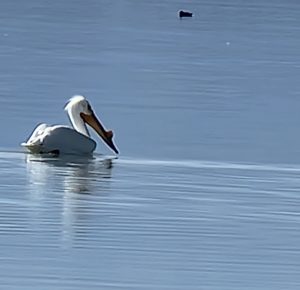
 There is no question that drought and climate change are effecting this iconic lake. Yet, the biggest hand in this environmental emergency, it turns out is the largely unbridled interests of big industry and agriculture. Aided and abetted by short sighted politicians, precious fresh water tributaries are continually being diverted away from the lake towards the unchecked demands of a growing urban population.
There is no question that drought and climate change are effecting this iconic lake. Yet, the biggest hand in this environmental emergency, it turns out is the largely unbridled interests of big industry and agriculture. Aided and abetted by short sighted politicians, precious fresh water tributaries are continually being diverted away from the lake towards the unchecked demands of a growing urban population.

 “Feathers fall; soft as a song, light as morning dreams.”
“Feathers fall; soft as a song, light as morning dreams.”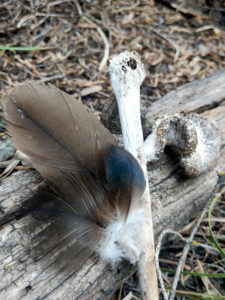

 Turns out it is the feather, as most Jurassic Park aficionados will gladly inform you. Flight was a later adaptation for this interesting feature, which it is theorized started out as an innovation for insulation or display. Sometimes I try to imagine beautifully plumed
Turns out it is the feather, as most Jurassic Park aficionados will gladly inform you. Flight was a later adaptation for this interesting feature, which it is theorized started out as an innovation for insulation or display. Sometimes I try to imagine beautifully plumed 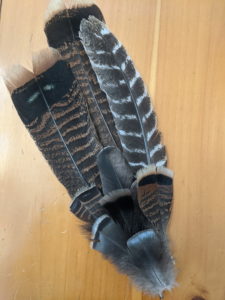
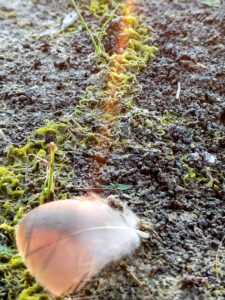 But many times, you run across a feather, or a feather runs across you, without any apparent rhyme or reason. I have had this happen on many occasions and each time I feel a sense of wonder, honor and gratitude.
But many times, you run across a feather, or a feather runs across you, without any apparent rhyme or reason. I have had this happen on many occasions and each time I feel a sense of wonder, honor and gratitude. Feathers, are perhaps the perfect medium for such events, because of their ethereal nature and their inherent connection to wings and flight…something that lends the ability to move through space in four dimensions versus three as us poor naked apes seem to be bound to, without the aid of artificial devices. Furthermore, the inclination for up and sky to be associated with “heaven” and flight with angels, promotes this doubly.
Feathers, are perhaps the perfect medium for such events, because of their ethereal nature and their inherent connection to wings and flight…something that lends the ability to move through space in four dimensions versus three as us poor naked apes seem to be bound to, without the aid of artificial devices. Furthermore, the inclination for up and sky to be associated with “heaven” and flight with angels, promotes this doubly. In actuality, however, birds often participate in what is called
In actuality, however, birds often participate in what is called 



